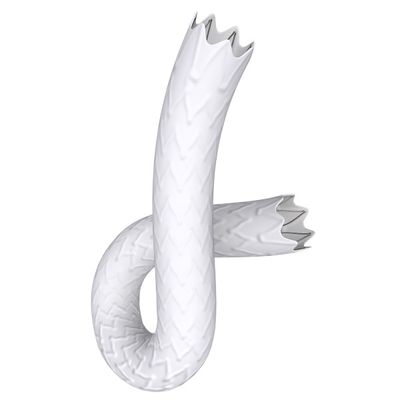

- Home
- Companies
- Bentley InnoMed GmbH
- Products
- BeGraft - Peripheral One-Layer Stent ...

BeGraft - Peripheral One-Layer Stent Graft System
This peripheral stent graft system excels with a high radial force whilst maintaining extraordinary flexibility and a low profile. The cobalt-chrome stent platform is covered with a micro-porous ePTFE membrane.
The BeGraft Peripheral Stent Graft System is indicated for intraluminal chronic placement in iliac and renal arteries for:
- Restoring and improving the patency
- Treating aneurysms, acute perforations, acute ruptures and fistulas
The BeGraft Peripheral Stent Graft System is not available in the US.
Non-clinical testing has demonstrated that the “BeGraft Peripheral Stent Graft” is MR Conditional. A patient with this device can be safely scanned immediately after implantation in an MR system meeting the following conditions:
- static magnetic field of 1.5 Tesla and 3 Tesla, with
- maximum spatial field gradient of 5,100 G/cm (51 T/m)
- maximum force product of 91,000,000 G²/cm (91 T²/m)
- theoretically estimated maximum whole body averaged (WBA) specific absorption rate (SAR) of 2 W/kg (normal operating mode)
Under the scan conditions defined above, the “BeGraft Peripheral Stent Graft” is expected to produce a maximum temperature rise of less than
- 2.7°C (2 W/kg, 1.5 Tesla) RF-related temperature increase with a background temperature increase of ≈ 1.4°C (2 W/kg, 1.5 Tesla)
- 2.1°C (2 W/kg, 3 Tesla) RF-related temperature increase with a background temperature increase of ≈ 1.0°C (2 W/kg, 3 Tesla)
after 15 minutes of continuous scanning.
The effect of heating in the MRI environment for overlapping stent grafts or stent grafts with fractured struts is not known. In non-clinical testing, the image artifact caused by the device extends approximately 12.4 mm from the “BeGraft Peripheral Stent Graft” when imaged with a gradient echo pulse sequence and a 3 Tesla MR system.
For further information, please see the current version of the IFUs.
